By Wang Chenchun, whose nickname at Alibaba is Mujian.
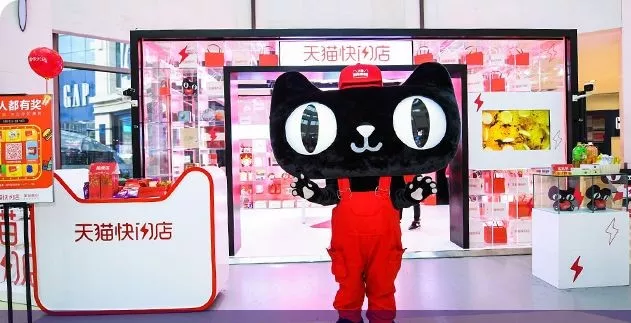
It was in 2016 when Alibaba first proposed the idea of "new retail ." And, not too long after that, we began to see several other major Internet companies and tech giants, and some big names in retail, and other businesses including hotel and hospitality companies as well as airports also actively exploring new retail models. For Alibaba's Tmall, a platform that serves numerous global brands, an important issue is finding a suitable means for assisting retail enterprises in their digital transformation and brand owners in leveraging big data and the technologies and computing power of the cloud to gain better insights about their consumers.
In this article, Wang Chenchun, who is a Senior Technical Expert at Alibaba Group, will share some of his thoughts on the "new retail" transformation of established brands.
This article is divided into several parts, which together work towards describing how Tmall's smart stores understand the concept behind and implementation of "new retail." In the first section, we will look into why Tmall chose to develop the existing offline brands market. In this section, we will also discuss what is the potential that lies ahead for this kind of market, as well as some of its core characteristics and advantages. Then, in the second part, we will cover how offline retail businesses can be reconstructed through store digitization. Then, following this, we will then look into how stores in the cloud can reshape the fundamental way in which businesses and retail work. And, last, we will discuss some of the challenges involved in the technological restructuring process.
In terms of scale, new retail can more or less be considered as something of an upgrade to conventional offline retail. A large number of offline in-stock stores correspond to what you could call "conventional brands." Yet, at the same time, these brands and their physical stores still have much room to explore in terms of their digital transformation journey. So, the question of how to update existing offline in-stock retail market, on a large scale, is a vitally important.
On the other side of things, for the past 20 years, digital commerce, or e-commerce, has also developed and expanded to an unprecedented level, accounting for approximately 20% of the total volume of global retail sales, and it is still growing. So then, where is the remaining 80%? How will things continue to change? And, in particular, how can we make change the remaining 80% percent through the implementation of new retail and a process of digital transformation?
Now also consider the fact that e-commerce focuses more on conversion rate and efficiency than conventional retail outlets. In reality, this is one of the most striking differences between online and offline retail. In digital commerce, it is normal to consider these following questions: How can we help consumers quickly choose what they want? And how can we increase the conversion rate of existing retail brands?
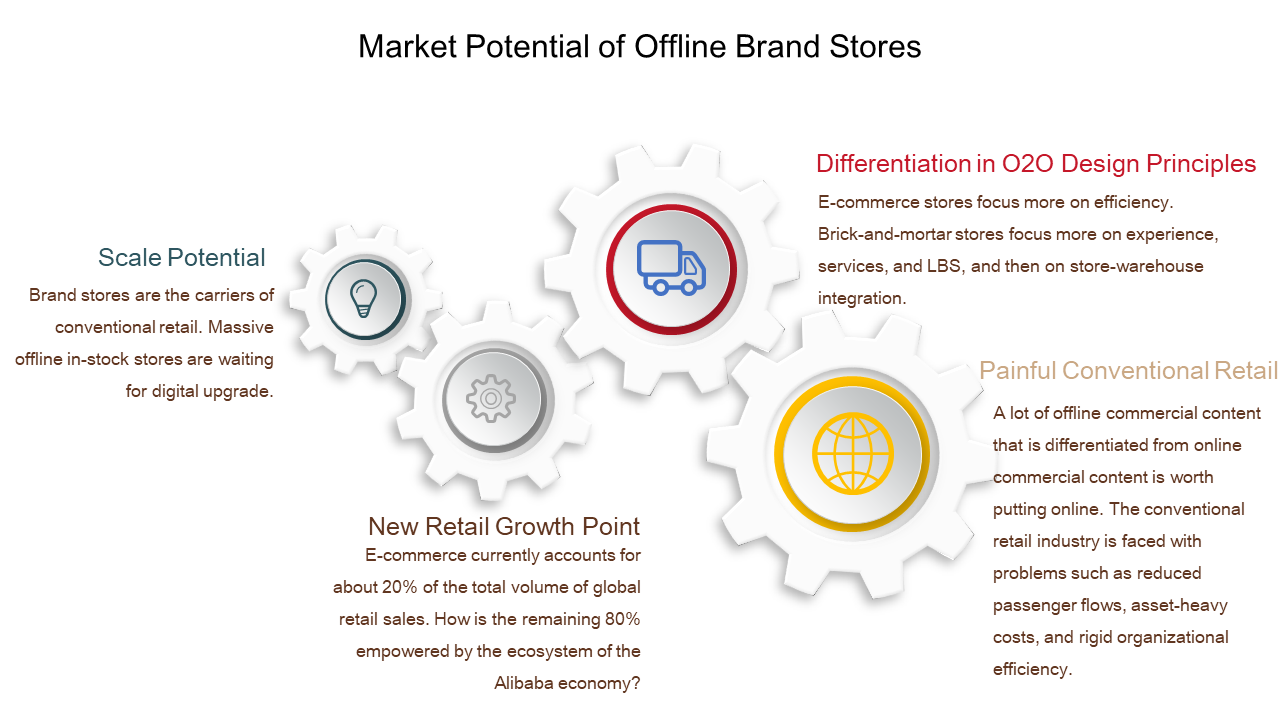
In contrast to the story we've presented about online retail, in offline shops, generally what you focus on are the customer experience and the questions of what and how can services be provided for them in an even better way. For example, services which have largely remained offline include things like beauty salons and individualized consultation services. This can be attributed, first, to the very physical nature of these services and, second, to the fact that these services are also very much location-based services.
However, through the exploration and implementation of "new retail" and the process of digital transformation, the order fulfillment capability of these sorts of traditional brick-and-mortar stores can also be improved. In particular, we can improve their fulfillment capability through decoupling the store-warehouse integration model often discussed in new retail.
Fourth, the pain points of conventional retail are also something that should be addressed. To illustrate this, let me provide an example.
Not too long ago, I went to a shopping mall. Originally, the business hours were from 10am to 10pm. I got there at 9:30 at night. Yet, they weren't preparing to close any time soon. In fact, I overheard a store manager say to one of the store clerks in a shop that, because the order volume of that day wasn't as large as expected, they would extend the closing time to at least a half an hour later to try to make up the sales.
For conventional retail brands, a considerable investment in heavy assets is required at early stages of business development. These investments include the costs of renting the physical premises or store front where the business will be located and of recruiting the required personnel to run and operate the business.
And, the reality is that rent and other personnel costs can eat up and even eat into a large part of the expenditures of a conventional retail business. In fact, even after a retailer has opened a store, recruited the necessary employees, decorated the store, and opened for business and regular operations, that retailer may still face several different issues and tight finances.
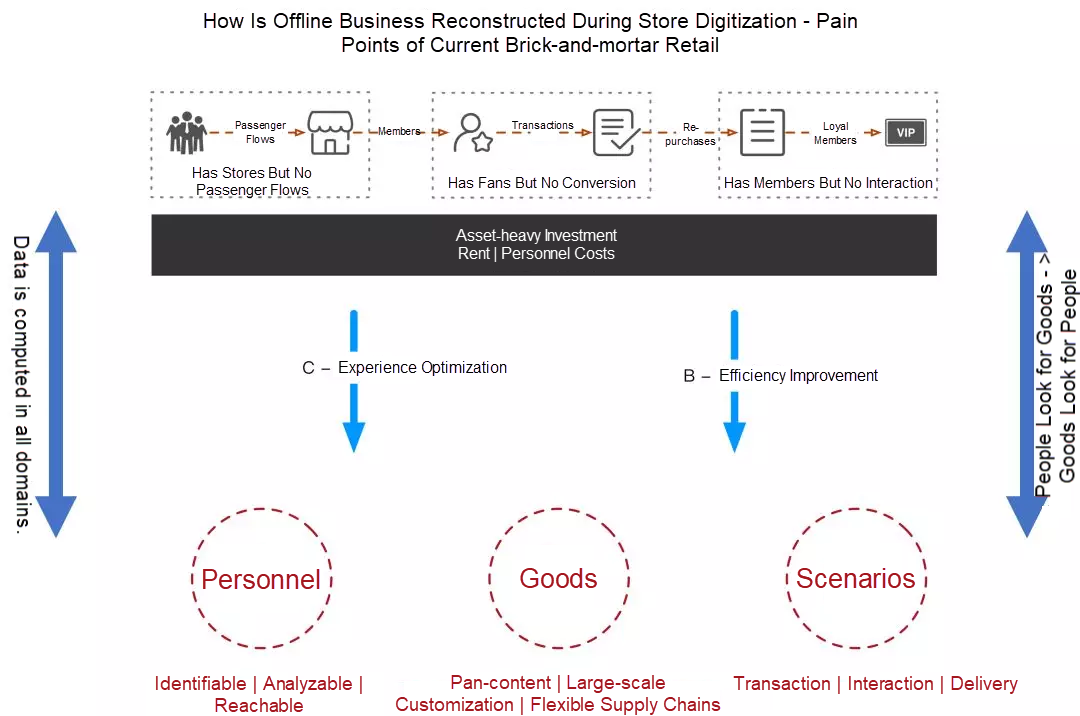
It is also possible that there may not be a steady flow of customers to come to the retail store. Of course, one interesting reason for this is that the number of offline customers has declined as e-commerce has gained a more prominent role in several markets. Then, there's also this problem. Many offline shoppers that come to visit stores may not necessary buy anything from the shop they're visiting. Rather, they may just decide to browse, or just become store members just so that they can get loads of discounts, which in some cases could end up hurting the retailer's bottom-line.
However, it can also be difficult to turn online shoppers into shoppers and buyers at conventional retail shops. One reason, among several others, is that these consumers are disconnected from the physical location of a conventional retail shop. Much effort is required to go to a physical location. Another reason is that it may be difficult for shopping clerks to communicate with member shops and establish a strong and stable connection with potential offline shoppers. Moreover, different from online markets, the offline retail market has a large amount of commercial content to be digitalized.
Just consider this. In the smart store scenario, we can optimize the overall shopping experience of customers and improve the overall efficiency of the connected businesses. To facilitate brand digitalization, we can also make the related people, goods, and stores identifiable, analyzable, and also reachable through big data, machine learning, and other applications and technologies in the cloud. By extension, doing so can provide a more extensive catalogue of content.
Then, you may ask, what is the expected result? What happens when businesses go on to the next steps of their digital transformation? When, say, offline commercial content, as well as this mass of entity data and process data, including such items as transactions, commodities, marketing content, and membership, become the pillars of a new system of retail, intelligent and connected to the cloud. Both the online and offline brand data can be computed and benefit from a process of digitalization. To sum things up, let's consider a few words by Dr. Wang Jian: Data is meaningless if it is simply stored, data only creates value if it is further computed.
So, so far, we have discussed the pain points of merchants. In reality, there's also much to discuss on the customer side, too.
Consider this example. One day I discovered that the frames of glasses I bought online were broken, so I asked the customer service of the online store whether I could go to one of their offline stores to repair my glasses. They said no. Rather, what I needed to do was discuss my issues with the after-sales service department and then they would take the glasses to the factory for repair. It took some two weeks before I could get my glasses, fixed, back in my hands. Not a very good customer service experience, may I say.
Now, just imagine if things were different. Imagine if the customer service personnel told me that I could just go directly to any of their brand's offline stores, or express deliver my glasses to an offline store to repair the glasses. Wouldn't it be a much better experience? As you can see, physical, offline stores are strongly characterized by their services and the experience they offer their customers, which are capabilities that differentiate them from online shops. New retail can adapt these advantages being a blend of online and offline commerce.
For smart stores, we have implemented the customer-brand-data (CBD) relationship to describe the value gained by sharing data among customers, a brand, and all the related data. Data can tell us things that we may not know or understand. A consumer can be directed to an online store in the cloud or an offline stores through far-field and near-field marketing. Stores in the cloud are important carriers for taking the commercial content of offline stores online and on the cloud. Therefore, the online carriers can, in many ways, be described as "cloud stores", as labelled below, and the offline carriers are physical stores.
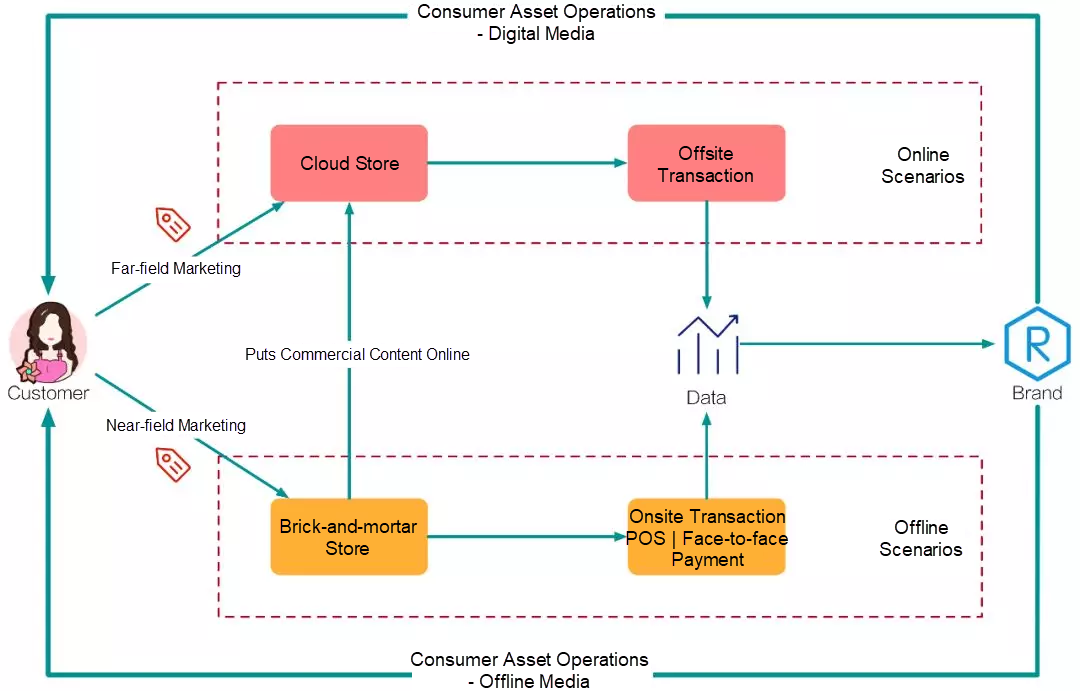
In offline stores, you can make onsite transactions using our cloud point-of-sale (POS) system and pay for items on Taobao directly in the store. These transactions can be digitized and accumulated onto the platform for additional computing.
However, in online stores, digital transactions can be completed directly in their respective "cloud stores," and the associated data is also stored for additional computing needs. And, after the data connected with all the associated domains is computed, the computed results are used to empower the specific brand. That is, based on these transactions, the brand owner can perform second-round operations on customer data and improve their overall distribution and produce more precise, targeted marketing campaigns for both digital and offline media channels.
Now let's discuss the marketing work we've done at Alibaba Cloud for new retail based on this customer-brand-data relationship.
So, you may be wondering what exactly does someone do when operating conventional e-commerce channels. Well, to put things simply, the answer is just managing traffic. In essence, we are operating the clicks of the consumers and the paths of the paths. We also make use of several different methods to direct customer traffic to pages with the highest conversion rates.
In reality, offline marketing runs on a similar principle to this. Business administrators want to be able to direct customer steps, so that they can affect the offline low of customer traffic.
This is how we understand it. For offline marketing, in the funnels filled with the total consumer traffic, the traffic of the entire market in all domains is at the upper-most layer. The traffic of the Alibaba system is at the second layer, and the near-field traffic is at the third layer. This near field may be a business district or a commercial street. And visits to the offline store by customers become onsite traffic at the fourth layer. Finally, transactions made by consumers at the store turn into the traffic at the lowest layer.
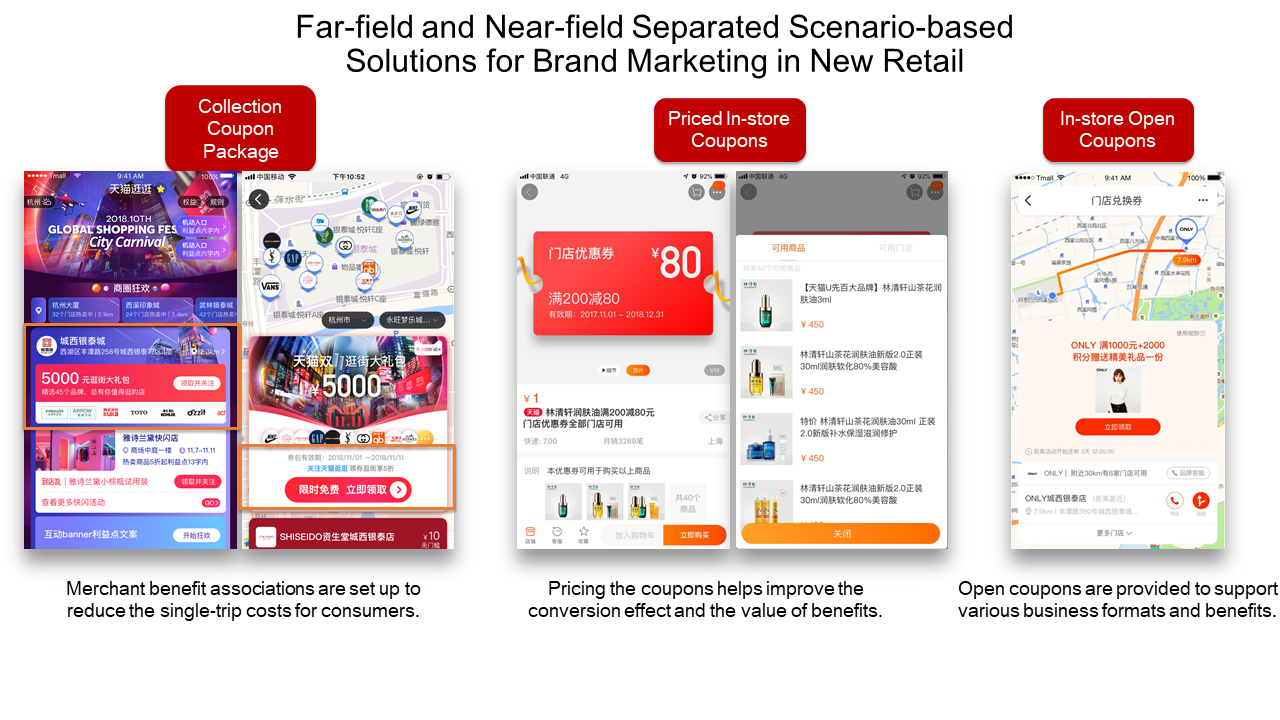
To do marketing in new retail, typically, you'll need to be able to distinguish between far-field and near-field marketing. Far-field marketing is mostly concerned with whether a transaction can be made online and, to a lesser extent, with whether consumers can be directed to the offline store through pointed marketing campaigns that direct them or entice them to make in-store orders. In contrast, near-field marketing focuses on the characteristics of individual customer and leads them to the smart store in Tmall based on their interests, wants, or needs.
In addition, we have developed many scenarios based on store coupons and vouchers, such as electronic coupon packages. In particular, we have focused on how to combine scattered shopping rewards and perks through coupon packages, and push these kinds of coupon packages based on specific scenarios. In addition, by promoting priced store coupons, we can help merchants increase the value of their shopping perks and the conversion rate. Last, we allow merchants to integrate some marketing methods of their internal system into our smart store system.
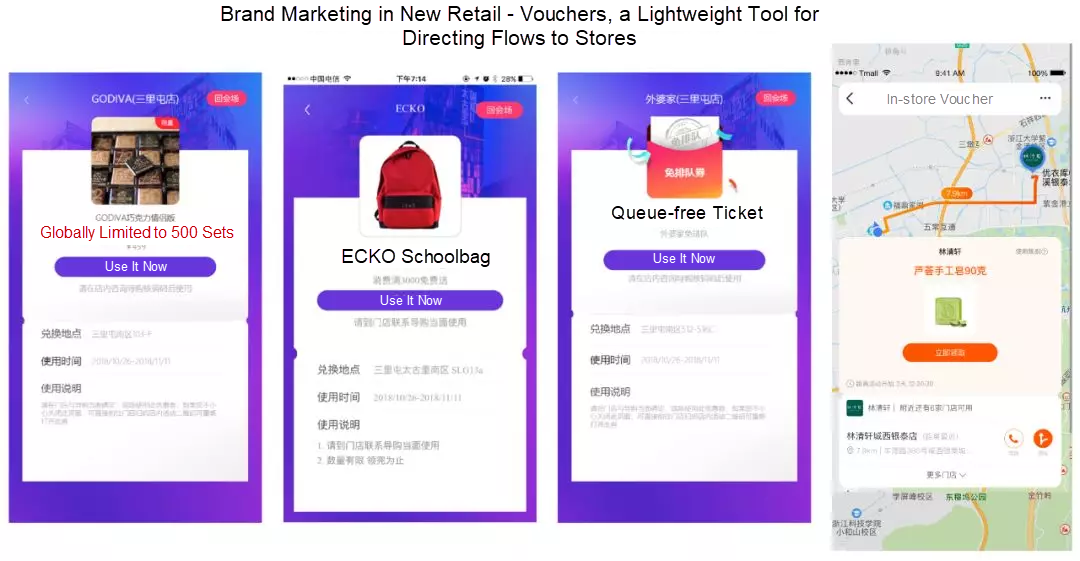
Vouchers are a lightweight and multi-mode marketing tool that can be used to help merchants direct traffic to stores. A coupon itself may appear in various forms, such as a trial suite, or a coupon for a purchasable item or service such as a schoolbag or an online course, or it could also be for some platform or in-store benefit. In addition, it's relatively inexpensive to distribute this type of coupon, and the redeeming these coupons is also rather simple.
Given the multiple vouchers modes we offer, we have also enhanced our location-based services. For example, Alibaba's full-featured map and navigation application AutoNavi, also known as Amap, can be used to tell consumers how to go to stores.
So, you may think that, why is the redemption rate of vouchers high? The reason is that coupons give customers a reason to go to the store. For a clearer illustration, consider this example. If a free sample attracts a consumer to go to the store, there is a high probability that the customer may make a second purchase. This is also the reason why many brands want consumers to return goods at physical stores. Although the consumers return goods, they may also make a second purchase while in store. If you are an e-commerce merchant, however, customers simply return goods to you by an express courier, which means that the customer is less likely to interact with the store again, as they are not required, after sending off the package.
Electronic coupon packages in many ways are analogous to a collection of various shopping perks and benefits. However, they are far from simply being a combination of some coupons, or a red envelopes. Rather, we focus more on the scenarios where the coupon packages are given to consumers.
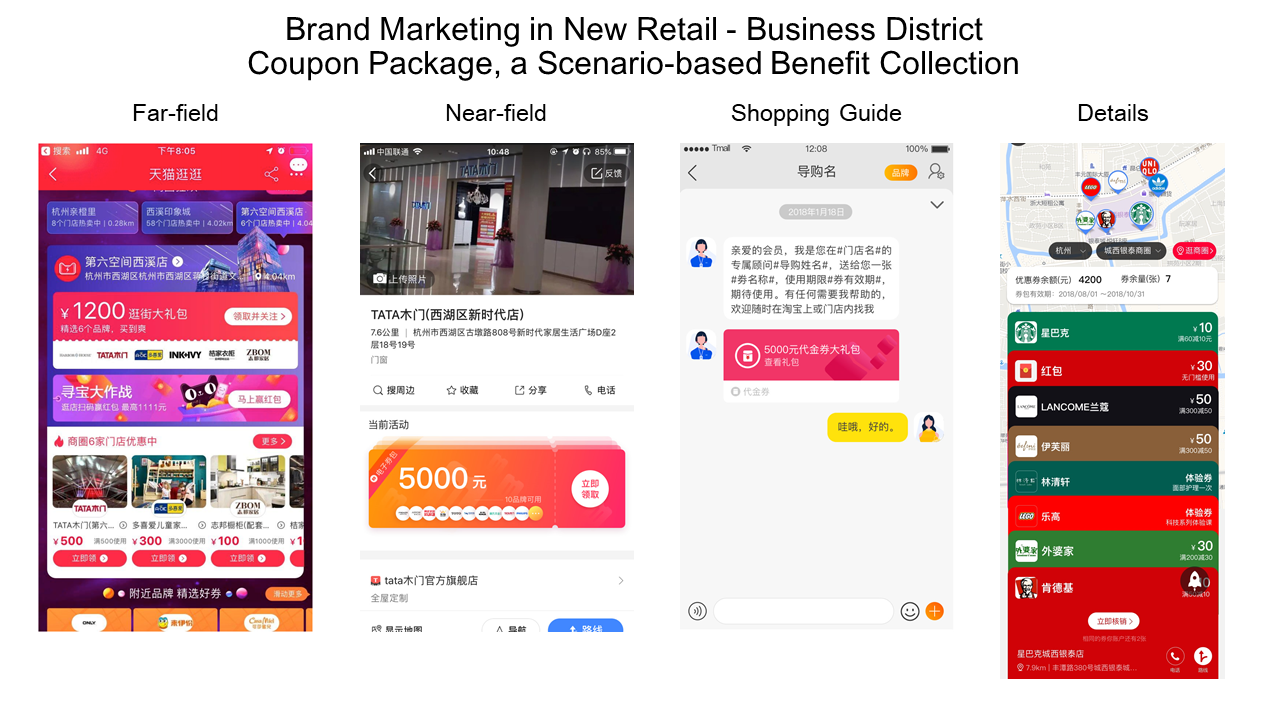
The first type of coupon package is a commercial district coupon package. For example, I could receive such a coupon package, which is exclusive to Intime business district when I arrive at Intime City, a major mall complex in Hangzhou. For me, then, this coupon package would cover several shopping perks and benefits for the smart stores located in Intime City. The consumer flow path is changed in the near field.
In terms of far field, consumers can claim these coupon packages from, say, Tmall Guangguang, or the details page of a destination in the map application of Auto-Navi. For instance, let's say I am going to some furniture store, I can get a coupon package from the furniture mall and then buy things at the physical shop. In addition, with smart promotions, store promoters can actively distribute these coupon packages to members. Also, in the details page on the customer side, merchants can make clear to customers how and where they can use these shopping perks.
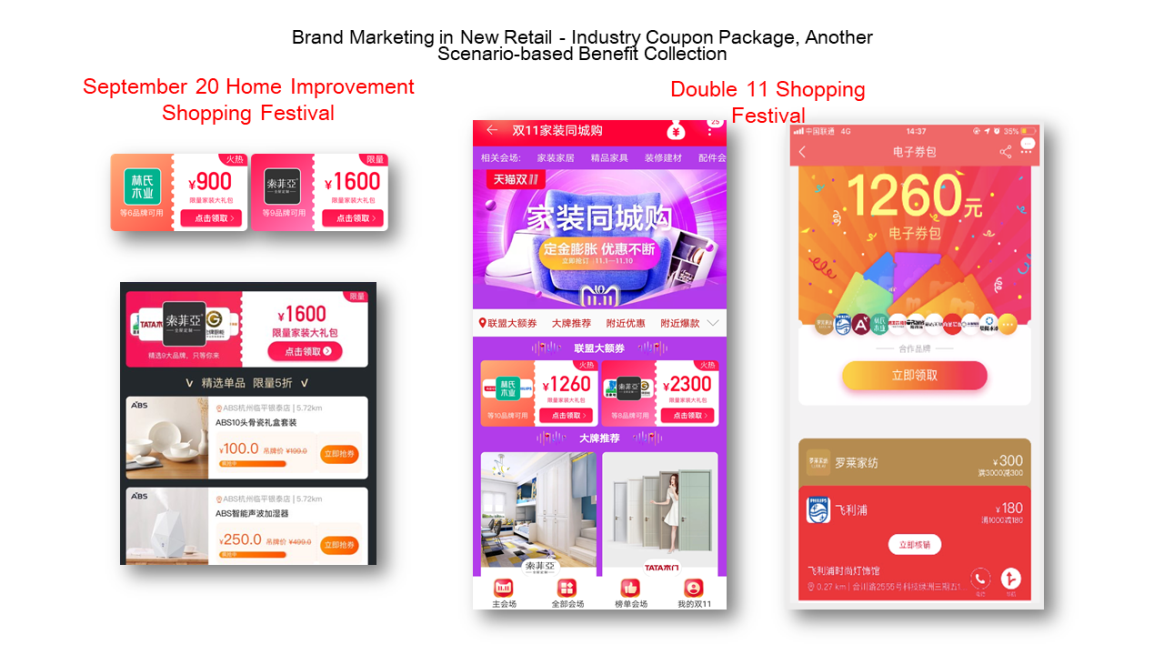
The second type of coupon package is the industry coupon package. We find that offline benefit associations exist in many industries. For example, in the decoration and home renovations industry, I believe that, when decorating or renovating a house, people do not buy one door alone, or simply one toilet and a few bricks, but rather a whole room or house worth of items. A home renovation and improvement coupon package works by combining a series of brand perks that do not conflict with each other into an electronic coupon package, which is powered by algorithms. When consumers go to a home furnishings or home improvement store, for instance, this coupon package allows them to be clear which stores have promotions, which increases the probability that the customer will visit the store.
In addition to business districts and industries, we will also have vouchers for other scenarios, such as mothercare and baby-related products, or supplies for parent-child weekend day trips. The key is to all of this is to aggregate the appropriate perks and system benefits into a benefit entity in an appropriate scenario and provide such thing to the customer.
Tmall's store coupons are also a new format. But, what is the biggest difference between Tmall's store coupons and our earlier e-commerce coupons? Tmall's store coupons can work both online or offline. Merchants can specify which stores, commercial districts, and in-store items are applicable.
The upper part of the customer-brand-data (CBD) relationship concerns online transactions. "Cloud stores" are the answer to how to enable physical stores to have digital operation scenarios and capabilities.
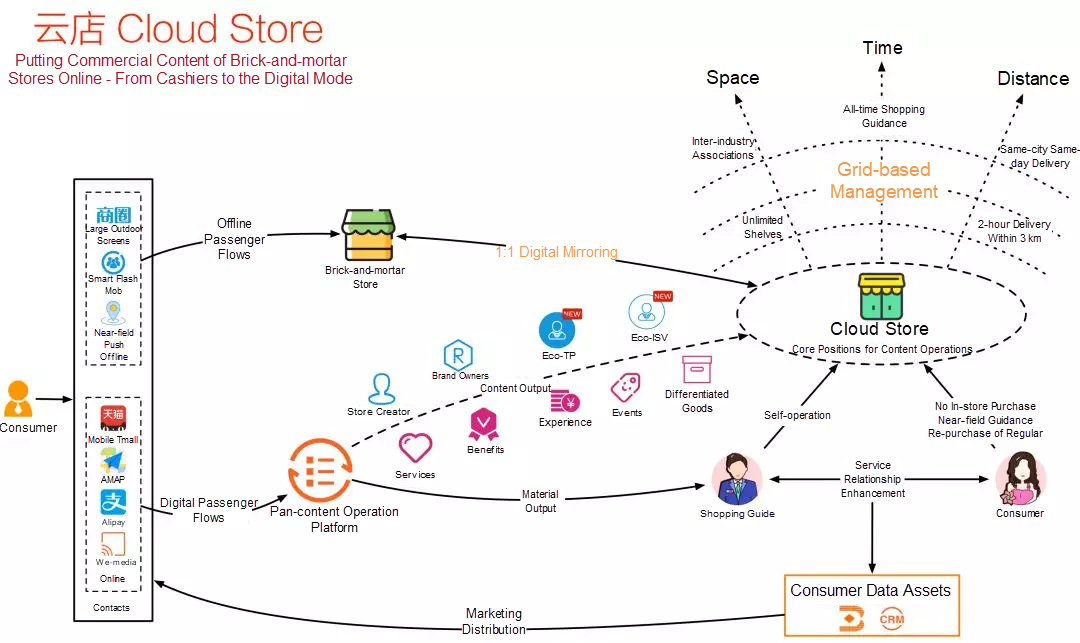
What is a cloud store? A cloud store is a store on the cloud which acts like a carrier for enabling the commercial content of brick-and-mortar stores to go online. We have a lot of offline commercial content, such as goods, rewards, discounts, and graphic content. All these content can be converted into a digital form in virtual stores in the cloud.
When considering the historical development of retail over the past 50 years, you may wonder what was retail like back then? The answer was it was sales on closed shelves with a small counter. At that time, if required a pack of cigarettes, the salesperson would have to give you the cigarettes to complete a transaction. Later, these closed shelves turned into open shelves, which is something now very common around the globe today. In large supermarkets around the world, such as Walmart, Carrefour, or Tesco, open shelves are also used to completely separate the cashier from the general shopping experience.
When it comes to today's digital marketplace, then, what exactly is upgraded, transformed, or improved in terms of the customer's shopping experience? Well, below we will show how a "cloud store" can resolve three major problems in offline retail.
First, stores on the cloud break the physical restrictions of offline stores. A brick-and-mortar store is restricted by its dimensions in physical space. However, when built online in the digital world, a store can not only sell good that are in stock at a particular physical location, but of several localities and also products of its co-brands.
In addition, a "cloud store" doesn't have business hours, as it doesn't require any employees to be running online. It can even be said that the store is more or less open and fully functional 24 hours a day, 7 days a week, provided that the customer service can reply to customers in a timely manner, and consumers can complete in-store transactions online. Finally, a virtual store in the cloud also breaks distance restrictions—customer don't have to travel far to get to the store.
Stores on the cloud also connect physical stores with customers who have already left their stores. In the conventional sense, when a consumer leaves a store, these two entities become irrelevant to each other. However, with the stores on the cloud and smart promotions, the store can continuously reach a customer, as this customer may be a store or brand member, and will receive notifications. In other customer-side scenarios such as Tmall Guangguang, customers can be reached through messages or subscription pushing. Messages such as "The store that you visited before has been having some promotional events lately!" or "The store that you visited before is holding an anniversary event. Come and see how much you can save!" can reach customers.
Third, the "cloud store" is also a self-sufficient station where offline stores can go online and be digitized. You may wonder, how did offline stores promote events or advertise sales in the past? Well, one example would be something like this: a promotion sign would be posted on the storefront door, which would detail the in-store promotion or sale. But, such advertisements are greatly limited by their physical location. Now that digital operations have emerged, the store in the cloud has become a ubiquitous item. It allows you to spread the content of your store in various channels. Such as Alibaba's own Taobao or Tmall platforms, or a specific store's own online store. Promotional and advertising content is no longer limited to conventional graphic content, products, or store perks, but it includes anything and everything you may think of.
So, what exactly is this kind of "cloud store"? A virtual store in the cloud, in all actuality, is the digital image of a physical store. When we say there is a such-and-such brand Intime City store, a corresponding such-and-such brand Intime City virtual store in the cloud also exists.
After these kinds of stores get rid of the physical restrictions of space and time, the service radius and consumption radius of customers also change, too. For example, if I live in the Xihu district of Hangzhou, I may visit Intime City and Xixi Incity more frequently. But, I would seldom go to AEON in Liangzhu or Raffles on the east side of the city, would it would be a waste of time. In the past, if I wanted to purchase something that is sold in a Raffles store, I would need to go there to purchase it. However, now all I need to do is to place an order at the respective "cloud store," and the merchant will deliver the goods from the online store in the cloud to me.
In the past, going online meant making a website for a store, with the assumption being that the nearest store is the best service provider. In contrast, in this wave of digitalization in the age of the "cloud store," physical stores can reach people even further away from you, and consumers can freely choose which store they want to interact with.
The cloud store had two important effects in last year's Double 11: preorders, or what we like to call pre-sales, and Youxianggou, which are exclusive sales that offer discounts and commission.
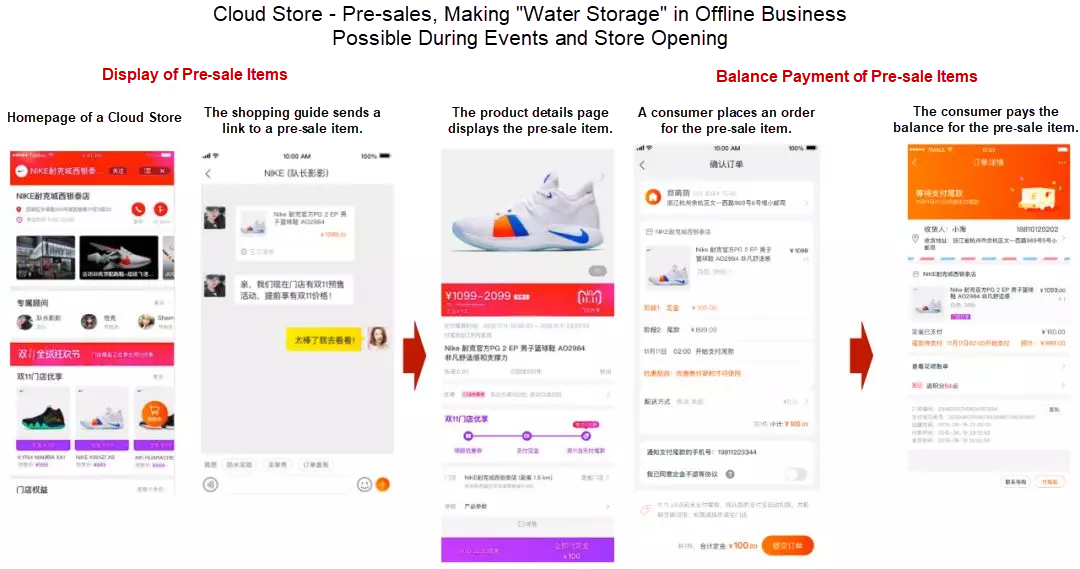
Preorders, or what you like to call "pre-sales," are similar to the idea of "pre-sales" in e-commerce, you could say, but their scenarios are a bit different. For example, if say I want to launch a promotional event, when there a big promotion going on at the store, or when there's already a big promotion going on online. However, there is a just a normal amount of customers visiting your store on a daily basis.
So, you may think then, what did we do in the past? Well, assume that you went to the store and asked the store clerk if the store is having a 30% off promotion. Then, you follow up by saying that you wanted to buy a piece of clothing and place an order right then. However, the clerk says that the event would not start until two days later and you wouldn't be able to purchase the item on discount just yet. Then, what would you do? Perhaps you would just leave the store, right? Or perhaps, you may ask for the clerk to put your item on hold and take your money, so you can purchase the item during sale in the coming days. So, you hand over the cash and wait until two days later when the clerk completes the transaction through the point-of-sale (POS) system. Although this form of transaction is not completely digitized.
We launched the preorder, or "pre-sales" payment method, for stores on the cloud to resolve problems such as items being sold out before you have the chance to buy and enable "purchase reservoirs" for store-initiated to-be-paid orders. It's been nicknamed "water storage" at Alibaba. For example, assuming that an event is to be held in half a month, we can start a "reservoir" for 10 days before the event. This "reservoir" in turn helps stores to avoid blindly stocking up items without any knowledge of the market demand. Moreover, for newly opened stores, preordering can be used as part of their opening event. It can attract some hype while also helping the business prepare. The pre-sale can start up to 10 days before the opening. And, through network marketing, the store can even attract a lot of traffic to its promotion sites.
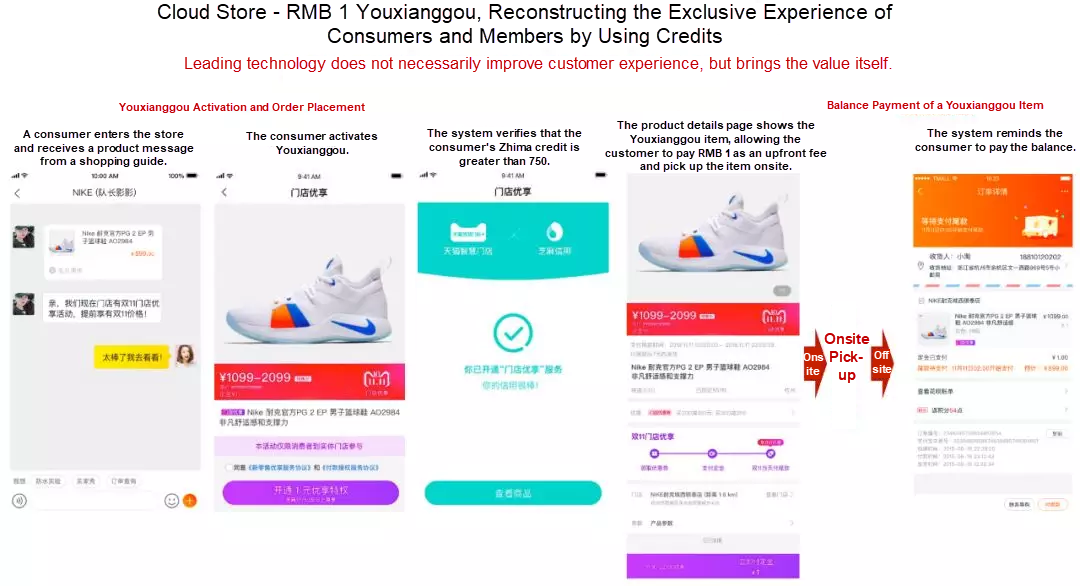
The preorder process is as follows: When a customer opens the homepage of an online store, the customer can see items, location-related information, promotions and in-store perks, and the exclusive module of the store. When the customer places an order for a pre-sale item, the customer sees an order placement page that is designed specifically for him or her. Then, the consumer enjoys a digital experience. However, this final experience is provided by the store through order fulfillment. If the customer has any questions, he or she can go to the customer service in the store.
Based on this preorder method, we have also created a mode called Youxianggou, literally meaning "shared discount shopping", which reconstructs the exclusive experience of customer and members through a credits system.
So, you may be thinking, when a customer becomes a member of a particular brand, what can the brand provide to the customer in addition to such straightforward things as discounts? Well, Youxianggou, or shared discount shopping, is an answer to this exact problem. If you are a member of any particular store or brand, you have relatively good Zhima Credits, also known as Sesame Credits, you can spend just ¥1 to get an item from the store, and make the balance payment before the specified time, or wait for the system to deduct the amount from your account automatically.
All of this makes for a much different in-store experience. If you're a member of DJI, for instance, when I enter the DJI store, you only need to spend ¥1 to get a new Mavic Air. This experience is actually also one of the most revolutionary aspects of new retail.
In addition to transactions, an online store certainly needs a position for shopping guides. This position is also an online digital position where a store can be operated. We call it a "store applet".
This applet can be spread by apps such as e-commerce platforms as Taobao or Tmall Mobile, or other Alibaba platforms like Amap and Koubei, and even Ele.me, Alibaba's popular food delivery app, in the future. Applets are similar to Java code programming because we can compile the code just once and then run the applet just about anywhere afterwards. This design provides a good technical foundation for the distribution of the online store's content.
In addition, in this applet, you can see various information about the store, such as available exclusive shopping guides, the geographical location, ongoing events, best-selling products, and available coupons. In reality, you don't need to go to the physical store at all. To learn everything about this store, all you need to do is view their store in the cloud. You can also place orders or claim discount coupons all online.
In the process of developing a store in the cloud, we also needed to overcome several technical challenges. The first challenge was that, when we just demonstrated a rich homepage of an online store, it turned out that the content of the virtual store's homepage came from a variety of data sources, such as the member data, benefit data, shopping guide list, graphic content, products, and special offers. So one question is then: how can we render all of these objects into one page as soon as possible? To answer this, we implemented parallel-query computation through using RxJava.
The second challenge involved the common problems we encountered when doing new retail business. Today, we have many flagship stores or Taobao stores online. However, we also need an offline entity to undertake the store's business.
In a flagship store, money is received by the transaction account of the flagship store. Then, orders are pushed to Alibaba Cloud RDS through CloudTmall, and then to the merchant's Enterprise Resource Planning (ERP) for subsequent order fulfillment and delivery. Finally, money is sent to the merchant's Alipay account after the customer confirms the receipt.
For an offline store, a store transaction is generated first. We will push the order to the corresponding RDS in the store in the cloud. The offline store fulfills the order, and the money goes to the store's account. Correspondingly, our other service is called omni-channel. It is actually a transaction at the flagship store. However, after the order is pushed to the e-commerce merchant's RDS, the physical store fulfills the order. Two most typical scenarios are in-store delivery and in-store pick-up.
When depicting offline retail products, we find that the description of offline products is very different from that of online products.
For an enterprise, the organizational structure is the most important piece, as it includes the following units in descending order from the top: the headquarters, and then some departments, which are further divided into several thousands of stores. Each store may sell one stock-keeping unit (SKU). However, you may find the difference between online and offline description of the SKU. The price of this SKU may vary from store to store, location to location. The price of the same SKU may also vary by channel.
Then, you may think, how can we depict this difference? Well, in addition to the price, we can also find other things that vary among stores. For example, things such as the product description, product photos, title description, and product details will also vary by store. In some online stores, also, a short video may be used to help provide a more in-depth look at the item or items the store is selling. All of these various things help to differentiate items and stores from each other.
The conventional e-commerce model is similar to this: The same price is set for the same model, and a single line in the relevant code record covers everything including the product title and price. However, later, many e-commerce systems upgraded in terms of their inventory model, introducing the concept and implementation of multi-warehouse systems. As we found in offline stores, more fields need to be redefined. Therefore, we started to upgrade the product model by working with Alibaba's business mid-end.
For a bottle of cola, take for instance, each instance of it will carry some inherent attributes, such as its volume which may be 300 ML and the fact that its logo is red. However, bottles of cola may have very different sales attributes in different offline and online shops. These attributes include different prices, different photos, and videos each can be different. Acknowledging all of these variations, we gather the variable attributes to the sub-product concept, and put the constant attributes to the concept of primary product. As such, the operational and customization requirements of offline stores can be fully satisfied.
For new retail, another important aspect to consider is how to improve customer experience while customers are physical stores. This piece of the puzzle is referred as the "offline scenario" or the "in situ transaction".
The main system involved in "in situ transactions" is the cloud point-of-sale (POS) system. It was originally used to resolve problems in the home improvement and automobile industries.
You may be wondering, on hearing this, why would shoppers want to buy automobiles online through Tmall rather than at automobile store, or automobile spare-parts or service center? Well, the answer may actually make you want shop for cars on Tmall, too. One reason why automobile shoppers choose Tmall is because of its wide variety of just about everything, from cars and SUVs, to various spare parts, to fancy seat covers. Moreover, on the online platform, shoppers can read a detailed description about the vehicles they'd like to purchase, and can purchase vehicles at reasonable prices without the need to haggle with a sales person.
When you decide to buy a car from Tmall and place an order, you can first pay an upfront fee and then go to the corresponding offline store to obtain your vehicle. At the same time, you can place the order and redeem your shopping perks and benefits through our point-of-sale (POS) system and make the large payment just by swiping your bank card—as you would do for other smaller purchases.
At Alibaba, we have developed an abundant host of features into the POS system for redeeming shopping rewards and other related support. Consider this example. Typically, money transferred by swiping your card will take a day or so to reach the merchant's account. To improve on this, we cooperated with Mybank to optimize the capital transfer system. And, in terms of marketing, offline stores can also use red envelopes, shopping allowances, and coupons that are applicable in both their online and offline stores. Last, in terms of stability, our POS system is highly stable and has been tested during two of Alibaba's Double 11 shopping events.
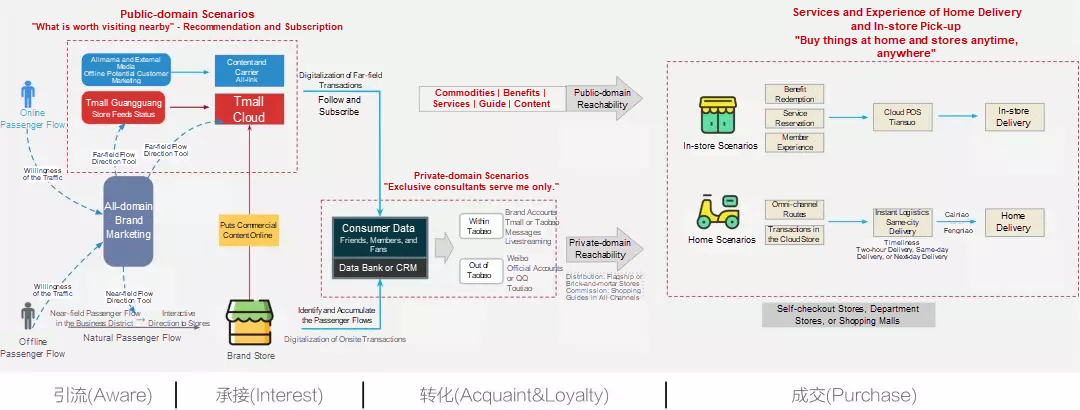
Now, let's take a look at the complex business relationship diagram shown above.
As a customer of modern online and offline retail, you are as much a digital entity as you are a physical person, and all brand marketing is directed at you and people like you no matter if you are a customer of a particular store or brand that is doing the marketing campaign. Therefore, when you're online, you are directed to the online customer-side terminal and then to the "cloud store," which deals with all the related transactions. And, likewise, when you're a customer in an offline store, you are guided by some particular marketing campaign offline to physical store near you, where also transactions are dealt with.
Things start to happen when customers can interact, shop, and carry out transactions in stores both on and off the cloud. Consider this for instance. You can go to a store and interact with a shop clerk, you can communicate with you to help you figure out exactly what you want. Then, you can see all of your in-store perks and rewards, its catalogue of products, through the "cloud store." Then, you can place the order by whichever way is most convenient for you, you can pay in person, you digitally through the cloud point-of-sale (POS) system. Of course, with the later, you don't have to be in the physical store, and in many ways, this makes the retail experience akin to other home delivery and food delivery services, like Alibaba's Hema and Ele.me services.
So, as you can see from the above, the way in which new retail works is that the offline and online channels are integrated and work together. They are powered and operated by customer service experiences on one side, and big data and AI on the other. When a customer makes a purchase, placing an order, the related data is directed back to the platform where it is converted and also checked to provide an additional level of security.
So, you may be wondering then, how can the digitalization of stores, in the evolution of new retail, help to restructure offline commerce? Well, in the past, brands were more or less the operating channel of retail business, but today, with a more customer-centric system in place, retail is more concerned with customer needs and wants, and retail aims at providing customers with a better service experience and fulfilling customer needs and completing customer orders.
Last, I would like to share my thoughts on the future outlook of new retail. One question to consider is what exactly does digital transformation mean when it comes to new retail? At Alibaba, we've been pondering this question for quite some time now. So, in this section, I would like to share our outlooks and perspectives.
But, before we do that, let's first take a look at the organizational structure of a conventional retail company. Below is a general diagram, so it by no means represents all companies in retail.
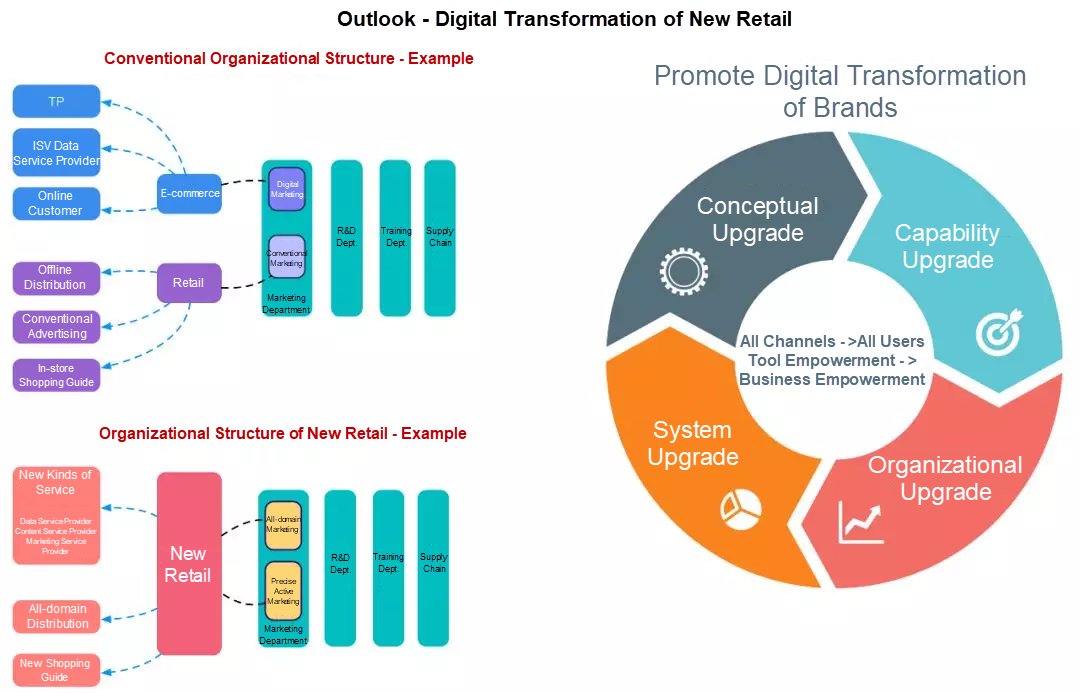
In addition to the supply-chain, human resources, and research and development departments, a company in retail will typically also have a marketing department, which is responsible for the marketing campaigns of both the e-commerce and traditional brick-and-mortar retail marketing channels.
E-commerce, at least in China, typically involves having a Taobao-partner company that helps the brand operate its flagship store on Taobao, an independent software vendor (ISV) that helps the brand develop the enterprise resource planning (ERP) system, and TradeManager's online customer service personnel which help answer questions from customers.
However, for retailers, it is more likely that what is involved is a rather different marketing channel of distribution; one which starts from the headquarters and then goes to the factories and then to the final stores. This channel is used to distribute the goods for brands. In addition, typical advertising methods such as TV ads are used. The final destination of this channel is the in-store clerk, who serves as guide to shoppers and a bridge between the brand and customers visiting retail stores.
This represents the "now," the status quo, for many companies in retail nowadays. So then, what sort of organizational changes do we expect to happen in retail in the future?
We think that the marketing department shouldn't separate digital marketing from more conventional means of marketing. Jack Ma one said something profound to this effect. He said that, in the future, no one will talk about "e-commerce" because it will be so ubiquitous that it will become the default form that retail will take.
The marketing department will be an integrated and dynamic department, one where e-commerce and conventional marketing will be combined into unified channel. That is, we envision a world in which online and offline retail are integrated and are not distinguished from each other. In such a world, you could easily return an item you bought online to a physical, offline store, and you could just as easily do the opposite. The two systems would be completely integrated with one another.
Our thoughts are also that, along with new retail, there will emerge several new and interesting phenomena and development, just as what happened when physical stores started to transition into e-commerce. That is, with the rise of e-commerce at least here in China, we saw the emergence of TradeManager's online customer service, as well as several other cultural phenomena such as e-commerce platform influencers, personalities, and models, and even the emergence of new jobs like Taobao store template designer. So, I cannot help but think that, new retail will also bring about many new and exciting opportunities and developments. For instance, perhaps ISV, which traditionally have only served as data service providers, may come to be transformed into companies that both operate over online content, even producing some viral content in the process.
We think that, with the rise of new retail, distribution will no longer just be concerned with offline retail distribution channels but very much concerned with both online and offline channels. And, what are not store clerks and shop assistant will be something else, and as a result, the customer relationship that these clerks maintain will just only involves those few regulars and the other customers that end up entering the store, but rather hundreds even thousands of brand members.
This, in our opinion, is the upgrade in terms of organizational architecture that many retail enterprises will complete in the future.
Then, what exactly does it mean by saying that Tmall can help upstart the digital transformation of various brands? In this article, we discussed several different concepts and products including cloud stores and the cloud point-of-sale (POS) system. These are all scenario-based solutions provided to merchants. Many brand owners say they are interested in the new retail concept and would like to take their hand at going through with these upgrades.
But, before anything can be done, an ideological change must happen first. That is, new retail involves several changes and costs, and a brand needs to organize a team that is designed specifically for new retail. Because with a new team comes a new vocabulary for change and an all-new organizational structure, and an entire new system and commercial solution. Today, brands can rely on our product matrix for their digital transformation into the new waters of new retail. Our experience and knowhow can strengthen their confidence and belief in new retail.
So, in this process, what is the difference between today's new retail and retail in the past? In the past, more attention was paid to the channels of distribution themselves. For, example, we were concerned with whether the goods were delivered through the logistics associated with e-commerce to customers or whether the goods were purchased in an offline store. However, today, the focus has largely shifted to customers. So what exactly is retail anyway? Well, according to Toshifumi Suzuki, former CEO and president of 7-Eleven, what retail really means is delivery what the customer wants when he wants it.
Follow this, at Alibaba we do not just want to provide a tool kit for merchant to sell goods and services, but even more so help merchants transform from tool-based empowerment into business-based empowerment. We hope that brands can experience the volume increases that new retail operations can bring about, whether business is coming from online or offline sources. We think that this transformation will be one for both in the world of business-to-business as well as business-to-consumer commerce.
Alibaba Clouder - January 22, 2020
Alibaba Clouder - November 25, 2020
Alibaba Developer - October 15, 2018
Alibaba Clouder - November 27, 2019
Alibaba Clouder - June 22, 2020
Alibaba Clouder - December 13, 2019
 Retail Solution
Retail Solution
Alibaba Cloud enables digital retail transformation to fuel growth and realize an omnichannel customer experience throughout the consumer journey.
Learn More Sports Solution
Sports Solution
From immersive stadiums to data analytics, our sports solutions empower teams, athletes, and fans through the digital transformation of the sports industry
Learn More Business Mid-End Solution
Business Mid-End Solution
This solution provides you with an enterprise-level omnichannel digital platform that gets your procurement and sales onto the same platform to enhance business competitiveness.
Learn More Financial Services Solutions
Financial Services Solutions
Alibaba Cloud equips financial services providers with professional solutions with high scalability and high availability features.
Learn More